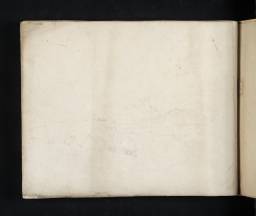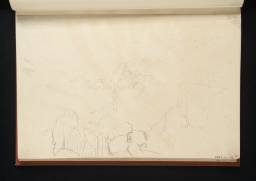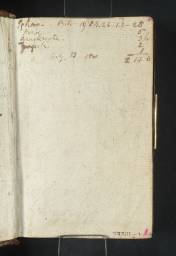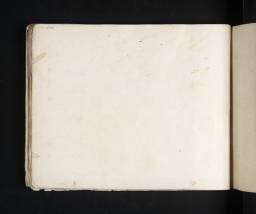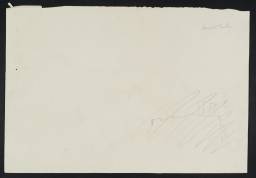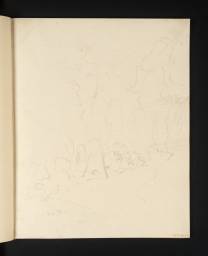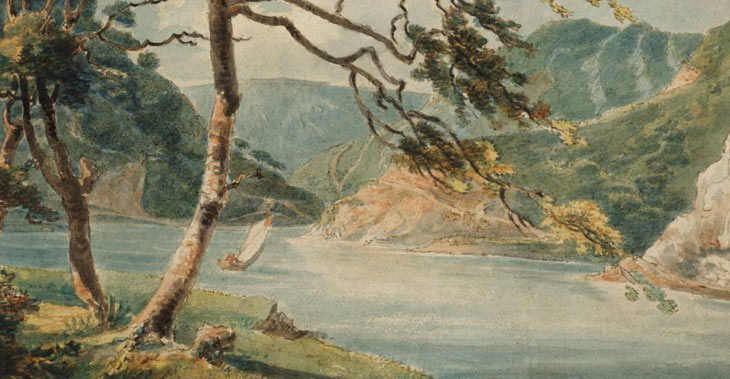Tour of the West Country 1811
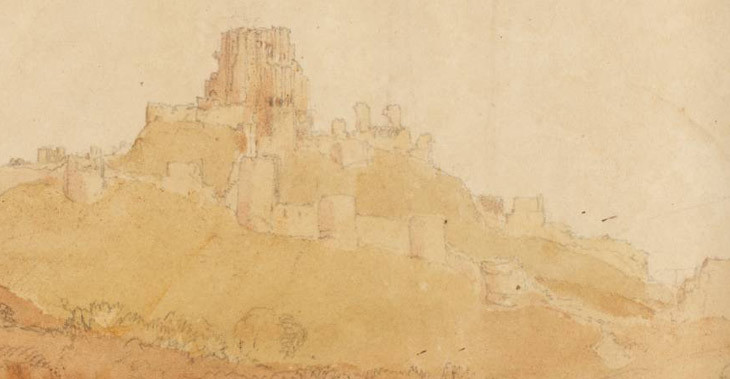
From the entry
Turner undertook an extensive tour of the region popularly known as the West Country of England in the summer of 1811. In a diary entry for 14 May 1812, Joseph Farington recorded a visit to the annual one-man exhibition at his fellow Royal Academician’s private London gallery in Queen Anne Street West: Turner’s Gallery I went to. His Father told me that Turner was out of town two months last Summer viz: from the middle of July to the middle of Septr. Making views on the Coast of Dorsetshire – Devonshire – Cornwall & Somersetshire – for Cooke’s work. Farington’s own tour of many of the same places in the autumn of 1810 perhaps prompted his conversation with Turner’s father as he viewed six oil paintings of Devon and Cornwall subjects, listed below along with the sketches on which they were based: The River Plym, untraced ever since; possibly the work now known as Hulks on the Tamar (Tate T03881; displayed at Petworth House, West Sussex) ...
Devonshire Coast, No.1 sketchbook 1811
D08362–D08806, D40902–D40906, D41520, D41521
Turner Bequest CXXIII 1–250
D08362–D08806, D40902–D40906, D41520, D41521
Turner Bequest CXXIII 1–250
Corfe to Dartmouth sketchbook 1811
D08807–D08822, D08824, D08826–D08842, D08844, D08846, D08848–D08863, D08940, D40821, D41522
Turner Bequest CXXIV 1–48
D08807–D08822, D08824, D08826–D08842, D08844, D08846, D08848–D08863, D08940, D40821, D41522
Turner Bequest CXXIV 1–48
Cornwall and Devon sketchbook 1811
D08941–D08942; D41275–D41296, D41299–D41373
Turner Bequest CXXV a 1–78
D08941–D08942; D41275–D41296, D41299–D41373
Turner Bequest CXXV a 1–78
Somerset and North Devon sketchbook 1811
D08945–D08964, D40294–D40295, D41531
Turner Bequest CXXVI 1–18
D08945–D08964, D40294–D40295, D41531
Turner Bequest CXXVI 1–18
References
Turner undertook an extensive tour of the region popularly known as the West Country of England in the summer of 1811. In a diary entry for 14 May 1812, Joseph Farington recorded a visit to the annual one-man exhibition at his fellow Royal Academician’s private London gallery in Queen Anne Street West:
Turner’s Gallery I went to. His Father told me that Turner was out of town two months last Summer viz: from the middle of July to the middle of Septr. Making views on the Coast of Dorsetshire – Devonshire – Cornwall & Somersetshire – for Cooke’s work.1
Farington’s own tour of many of the same places in the autumn of 18102 perhaps prompted his conversation with Turner’s father as he viewed six oil paintings of Devon and Cornwall subjects, listed below along with the sketches on which they were based:
Turner had visited the counties Farington notes, as well as sites in Buckinghamshire, Hampshire and Wiltshire. Except for an apparently isolated visit to Dunster Castle in Somerset in the late 1790s, when he might possibly have gone a little further west to meet his father’s North Devon relatives,9 he seems not to have ventured previously beyond Wiltshire and Bristol. Some sites to the south-west had been listed on the flyleaf of the 1798 Dinevor Castle sketchbook (Tate D41434) and in the Dolbadarn sketchbook, in use a little later (Tate D02174, D02175; Turner Bequest XLVI 119 and 119a), and on 6 April 1805 he had written to his Wiltshire patron Sir Richard Colt Hoare about fulfilling an ongoing commission: ‘perhaps I may be able before I go to Devonshire, but even then I fear the Summer will be far advanced.’10 However, there is no further evidence of such a trip at that time.
There must have been some prior notice of Turner’s 1811 tour. His subsequent friend and executor, Sir Charles Lock Eastlake, then a seventeen-year-old Royal Academy student and a native of Plymouth, wrote to his father there in July: ‘What he [Turner] wants is to go on board some large ship, and I daresay George [Eastlake’s brother] will be very happy to take him on board the Salvadore, and perhaps into the Dockyard, &c. He is the first landscape painter now in the world ... I hope all at Plymouth will be attentive to him’.11 Eastlake would be one of Turner’s companions during his 1813 visit to Devon, covered in a separate section of the present catalogue.
Turner’s main focus was a thorough survey of key sites along the coast. The paintings shown at his gallery were really by-products of his topographical research for watercolours commissioned by W.B. Cooke for a proposed series of engraved Picturesque Views on the Southern Coast of England (see below for an outline of the project and list of the compositions).12 As well as quoting Farington’s diary, Finberg established the widest possible time-frame for the tour by noting Turner’s presence at a Royal Academy Council meeting on Thursday 11 July and his absence the following week (16 July), his next attendance being on Monday 7 October at ‘the first Council meeting of the season’.13 Further evidence of the route appears in Turner’s own extensive list of numbered banknotes at the back of the Devonshire Coast, No.1 sketchbook, annotated with the places at which they were spent or broken14 (see the entries for Tate D40905, D40906; verso of Turner Bequest CXXIII 253 and inside back cover), and brief accounts from the very beginning of the tour in the same book (Tate D08362; Turner Bequest CXXIII 1).
Combining entries from these documentary sources with the main subjects he had identified in his 1909 Inventory of the Turner Bequest, Finberg was able to draw up an itinerary,15 with which a selection of further sites (many of which he also recognised) is incorporated here:
Buckinghamshire:– Ankerwycke; Surrey: Egham, Bagshot; Hampshire:– Blackwater, Hook; Wiltshire:– via Salisbury; the beginning of the main coastal tour in western Hampshire (now part of Dorset):– Christchurch; Dorset:– Poole, Corfe Castle, Swanage, Lulworth, Dorchester, Weymouth, Portland, Bridport, Charmouth, Lyme Regis; South Devon:– Sidmouth, Exeter, Teignmouth, Torbay, Brixham, Newton Abbot, Berry Pomeroy, Dartmouth, Totnes, Ivybridge, Plympton, Plymouth; Cornwall:– Saltash, Looe, Fowey, Lostwithiel and Restormel Castle, St Mawes, Falmouth, Penzance, St Michael’s Mount, Land’s End, St Ives, Redruth, Bodmin, Wadebridge, Padstow, Tintagel, Boscastle, Bude; North Devon:– Clovelly, Bideford, Barnstaple, Ilfracombe, Combe Martin; Somerset:– Minehead, Dunster, Watchet, Bridgwater, Cheddar Gorge, Glastonbury, Wells, Frome; Wiltshire:– Stonehenge, Amesbury, and returning to London via Salisbury
Finberg also listed Basingstoke, Hampshire, at the start of the tour, but the relevant sketches fall towards the end of the Devonshire Coast, No.1 sketchbook, suggesting that they were drawn on the way back.
Farington’s route by mail coach to Salisbury on the early stages of his 1810 West Country trip, recorded in his notebook-diary, may have been Turner’s too: ‘Staines | Bagshot | Hartford Bridge [Hartfordbridge] | Basingstoke | Overton | Andover’.16 Taking Salisbury as the start and end of the main tour, Turner’s journey comprised a continuous clockwise circuit of very roughly six hundred miles. He was said to have made brief visits to his Devon-born father’s relatives on opposite sides of the county at Exeter and Barnstaple,17 but apart from Farington’s diary and Eastlake’s letter there are no independent contemporary documents relating to his West Country activities in 1811, unlike the extensive reports of his return visit to Devon in 1813. Turner probably also went there again in 1814, and these trips are dealt with in a separate section of the present catalogue. Focusing as he did on Continental tours from 1817 onwards, he seems never to have returned to the region, but his sketches provided source material for many years to come.
Six sketchbooks were used on the 1811 tour, only three of which are of conventional construction. Devonshire Coast, No.1 (Turner Bequest CXXIII) is actually a copy of Samuel Coltman’s British Itinerary, a small printed book of distances between places with interleaved blank pages. It was used continually except along the far western and northern coasts of Cornwall, sometimes supplemented by more detailed studies of the same sites in the larger sketchbooks. Corfe to Dartmouth (Turner Bequest CXXIV) and Ivy Bridge to Penzance (Turner Bequest CXXV), two similar, conventional sketchbooks, record Dorset, South Devon and the south coast of Cornwall as far as St Michael’s Mount. Cornwall and Devon (Turner Bequest CXXV a) covers the far west of Cornwall and the northern coast of these counties as far as Combe Martin; it appears to have been a sheaf of loose sheets, bound comparatively recently. Somerset and North Devon (Turner Bequest CXXVI), broken up at an unknown date, ranges from Ilfracombe in Devon to Dunster in Somerset. Finally, Stonehenge (CXXV b), originally another bundle of loose sheets, records the ancient Wiltshire monument in detail, along with Cheddar Gorge, encountered in Somerset earlier on the homeward leg.
The Vale of Heathfield sketchbook (Tate; Turner Bequest CXXXVII), named after one of its Sussex subjects, was in use over a few years before and after 1811, and includes notes from a guidebook on Dorset and Devon sites which Turner visited that year (Tate D10206, D40864; Turner Bequest CXXXVII 1 and inside the front cover). It may, as Finberg notes, have ‘formed part of Turner’s baggage on his “Southern Coast” tour’,18 and includes views of Christchurch and Lulworth Cove, visited in 1811 and recorded at that time in other sketchbooks, as well as of sites associated with the 1813 stay in Devon, but it is grouped with other Sussex material in the present catalogue.
There have been various detailed accounts of the commissioning and execution of the Picturesque Views on the Southern Coast of England project by W.B. Cooke and his associates, in collaboration with publishers John Murray and the Arches, particularly in terms of Turner’s watercolours and the engravings made from them.19 Initially he was asked to provide twenty-four designs, but his contribution eventually ran to forty. As indicated below, some were based on later sketches.
It is a moot point as to quite when Turner composed the extensive descriptive and narrative verses relating to the West Country, which he proposed to publish as an accompaniment to his Southern Coast designs, in the Devonshire Coast, No.1 sketchbook (Tate; Turner Bequest CXXIII). The issue is discussed in the introduction to that book.
The engravings were issued between 1814 and 1826 and subsequently as a book, published by John and Arthur Arch and others as Picturesque Views on the Southern Coast of England, from Drawings Made Principally by J.M.W. Turner, R.A. and Engraved by W.B. Cooke, George Cooke, and Other Eminent Engravers (London 1826). A copy with volumes I and II bound as one is held in the Tate Britain Prints and Drawings Room, and separately accessioned plates in the Tate Collection are noted below.
The West Country designs are listed below as numbered and titled in the 1826 edition, which presents the overall series in sequence, following the coast clockwise from Whitstable in Kent to Watchet in Somerset – that is, from the Thames Estuary via the South Coast to the Bristol Channel. Details of the source watercolours are given, as are references to the most directly relevant pencil sketches. Turner often made other drawings at the same sites, which are cross-referenced in individual catalogue entries. The smaller engravings after other artists, of which there are impressions in the Tate Collection, are listed in sequence; Turner also drew some of these places.
Dorset: vol.I, plates:
40. Poole, Dorsetshire. Watercolour, circa 1812 (private collection); engraved 1814: Tate T04372, T05326–T05337.20 Sketch: Tate D08387 (Turner Bequest CXXIII 14)
41. Corfe Castle, Dorsetshire. Watercolour, circa 1812 (Fogg Art Museum, Cambridge, Massachusetts); engraved 1814: Tate T04377, T05338–T05346, T05966.21 Sketch: Tate D08826 (Turner Bequest CXXIV 17)
Dorset: vol.II, plates:
One of the unengraved watercolours related to the series by Andrew Wilton appears to be a view of the Isle of Wight from Christchurch, Dorset (then in Hampshire), the first coastal site on the 1811 tour: Coast Scene, with White Cliffs and Boats, ?circa 1815–20 (Yale Center for British Art, New Haven).28 Sketches: D08403, D08411 (Turner Bequest CXXIII 22, 27).
Devon (south coast): vol.II, plates:
[50. Salcombe, Devonshire. 1824 engraving after William Collins: Tate T05371]
[55. Dartmouth Castle. 1825 engraving after Samuel Prout: Tate T05388, T05389. Compare Turner’s sketches: Tate D08366, D08785 (Turner Bequest CXXIII 3, 237); and his watercolour Dartmouth Castle, on the River Dart (Tate D18137; Turner Bequest CCVIII D),31 engraved for the Rivers of England series in 1824]
57. The Mew Stone, at the Entrance of Plymouth Sound, Devonshire. Watercolour, circa 1814 (National Gallery of Ireland, Dublin); engraved 1816: Tate T04383–T04385, T05392, T05393, T05970.33 No 1811 sketches; see the Plymouth, Hamoaze sketchbook (Tate; Turner Bequest CXXXI) under the 1813 tour
60. Plymouth Dock, (seen from Mount Edgecumbe) Devonshire. Watercolour, circa 1814 (Plymouth City Museum and Art Gallery); engraved 1816: T04387, T05398–T05400, T05972.35 Sketch: Tate D08877 (Turner Bequest CXXV 11)
Wilton also lists an untraced watercolour of about 1820, Plymouth Harbour: Towing in French Prizes, as a related subject.37 A long-unrecorded watercolour of Babbacombe Bay from near Teignmouth (private collection) has been dated to about 1811 and related to the Southern Coast by Eric Shanes;38 Babbacombe is mentioned in Turner’s poetry in the Devonshire Coast, No.1 sketchbook (Tate D08670; Turner Bequest CXXIII 161a), and there appears to be a small, related sketch in the same book (Tate D08491; Turner Bequest CXXIII 64a), together with another view of the same coastline (Tate D08498; Turner Bequest CXXIII 68).
Cornwall: vol.II, plates:
64. Entrance of Fowey Harbour, Cornwall. Watercolour, circa 1818 (private collection); engraved 1820: Tate T05406–T05408, T05983.40 Sketch: D08889, D08890 (Turner Bequest CXXV 18a–19)
72. Tintagel Castle, Cornwall. Watercolour, circa 1815 (Museum of Fine Arts, Boston); engraved 1818: Tate T05436–T05443, T05980.46 Sketch: Tate D41308 (Turner Bequest CXXV a 32)
Devon (north coast): vol.II, plates:
Somerset: vol.II, plates:
80. Watchet, Somersetshire. Watercolour, circa 1818 (untraced); engraved 1820: Tate T04397, T05455–T05463, T05981.52 Sketch: Tate D08687 (Turner Bequest CXXIII 170a)
Turner’s Southern Coast subjects from counties further east, for which many of the watercolour designs are traced, were engraved as follows: Bexhill (1817),53 Margate (1824),54 Rye (1824),55 Ramsgate (1824),56 Hythe (1824),57 Portsmouth (1825),58 Brighton (1825),59 Folkestone (1826),60 Deal (1826),61 Dover (1826),62 Whitstable (1826);63 further related but unengraved subjects listed by Wilton are Dover,64 Rye65 and Margate.66
There are numerous other West Country watercolours, mostly associated with engraving projects, which are sometimes based on later drawings. They are grouped here for convenience:
The Rivers of Devon, 1815–23:67
The following work was not engraved for the series, but has been linked to it:73
Marine Views, 1824–5:75
The following work was not engraved for the series, but has been linked to it:77
The Rivers of England, 1823–7:79
Dartmouth Castle, on the River Dart. Watercolour, 1822 (Tate D18137; Turner Bequest CCVIII D); engraved 1824: Tate T04802–T04804.80 Sketches: compare Tate D08366, D08785 (Turner Bequest CXXIII 3, 237)
Okehampton Castle, on the River Okement. Watercolour, circa 1824 (Tate D18138; Turner Bequest CCVIII E); engraved 1825: Tate T04805–T04807.81 1813 sketch: Tate D09872 (Turner Bequest CXXXIV 71)
The Ports of England, 1826–8; and The Harbours of England, 185684
Little Liber, c.1820–589
Picturesque Views in England and Wales, 1827–3891
The watercolour vignette of The Bellerophon, Plymouth Sound was made in about 1833 as an illustration to Sir Walter Scott’s Life of Napoleon (private collection; engraved 1835: Tate T04982, T06270).107 It depicts Napoleon after his 1815 surrender as a tiny, distant figure on board HMS Bellerophon, surrounded by sight-seers in small boats, but with no land showing.
Apart from Crossing the Brook, exhibited at the Royal Academy in 1815 (Tate N00497)108 and based on sketches made on the 1813 tour discussed elsewhere in this catalogue, only two further West Country oil paintings are known, from much later in Turner’s career. Of these, The Prince of Orange, William III, Embarked from Holland, and Landed at Torbay, November 4th, 1688, after a Stormy Passage, exhibited at the Royal Academy in 1832 (Tate N00369)109 is a historical piece with contemporary political resonances, but, as with the Bellerophon vignette, the setting is at sea. However, St Michael’s Mount, Cornwall, exhibited at the Royal Academy in 1834 (Victoria and Albert Museum, London),110 is related to 1811 studies, being based on the Southern Coast design (1826 edition, pl.68) listed above.
See Kathryn Cave (ed.), The Diary of Joseph Farington, vol.X, New Haven and London 1982, pp.3717–817.
Martin Butlin and Evelyn Joll, The Paintings of J.M.W. Turner, revised ed., New Haven and London 1984, p.84 no.118; see also Smiles 2006, pp.18–19 for these works.
Smiles 2006 pp.13, 51 note 3; see also Andrew Wilton, J.M.W. Turner: His Life and Work, Fribourg 1979, pp.312–13 nos.119–121, and Eric Shanes, ‘Picture in Focus: Dunster Castle, Somersetshire, South-West View’ and ‘Picture in Focus: Dunster Castle, Somersetshire, North-East View’, Turner Studies, vol.1, no.1, [Summer 1981], pp.50–1 and 52 respectively.
John Gage, Collected Correspondence of J.M.W. Turner with an Early Diary and a Memoir by George Jones, Oxford 1980, p.25 letter no.8; quoted in Smiles 2006, p.13.
Letter transcribed in Lady Eastlake, ‘Memoir of Sir Charles Lock Eastlake’ in Sir Charles Lock Eastlake, Contributions to the Literature of the Fine Arts: Second Series, London 1870, p.23; quoted in Gage 1968, p.678, Hamilton 1997, p.145, and Smiles 2006, p.19; see also Sam Smiles, ‘Turner in Devon: Some Additional Information Concerning his Visits in the 1810s’, Turner Studies, vol.7, no.1, Summer 1987, pp.11–14..
For some general accounts of the tour and the Southern Coast project see: Finberg 1961, pp.182–3; Gage 1987, pp.42, 44, 195–7; Wilton 1987, pp.102–4, 124; Hamilton 1997, pp.142–6; Kennedy 2001, pp.64–5, 76; Hamilton 2003, pp.99–108; Smiles 2006, pp.12–15, 19; Wilton 2006, pp.90–1, 231.
See particularly: W[illiam] G[eorge] Rawlinson, The Engraved Work of J.M.W. Turner, R.A., vol.I, London 1908, pp.xc–xci, 44–68 nos.88–127; Alexander J. Finberg, An Introduction to Turner’s Southern Coast, with a Catalogue of the Engravings in Which All the Known Working-Proofs Are Arranged and Described for the First Time, and a Full Transcript Is Made of Turner’s Marginal Notes and Instructions to the Engravers, London 1929; Eric Shanes, Turner’s Rivers, Harbours and Coasts, London 1981, pp.6–8; Wilton 1979, pp.350–5 nos.444–489; Eric Shanes, Turner’s England 1810–38, London 1990, pp.8–10; Luke Herrmann, ‘Southern Coast of England, Picturesque Views of [sic] the’ in Evelyn Joll, Martin Butlin and Luke Herrmann (eds.), The Oxford Companion to J.M.W. Turner, Oxford 2001, p.307.
Wilton 1979, p.352 no.456, reproduced; Rawlinson I 1908, pp.xc, 53–4 no.99 (see also pp.xc, 54 no.99a).
Eric Shanes, ‘Picture note 3: Babbacombe Bay from near Teignmouth’, Turner Studies, vol.10. no.1, Summer 1990, p.60, reproduced.
Wilton 1979, p.350 no.444, reproduced; Rawlinson, I, p.cxv, II, p.415 no.851, as ‘The Banks of the Tavy’.
Wilton 1979, p.357 no.506; Rawlinson I 1908, p.cix, II 1913, p.372 no.771, p.373 no.773 (small replica).
How to cite
Matthew Imms, ‘Tour of the West Country 1811’, July 2011, in David Blayney Brown (ed.), J.M.W. Turner: Sketchbooks, Drawings and Watercolours, Tate Research Publication, December 2012, https://www

